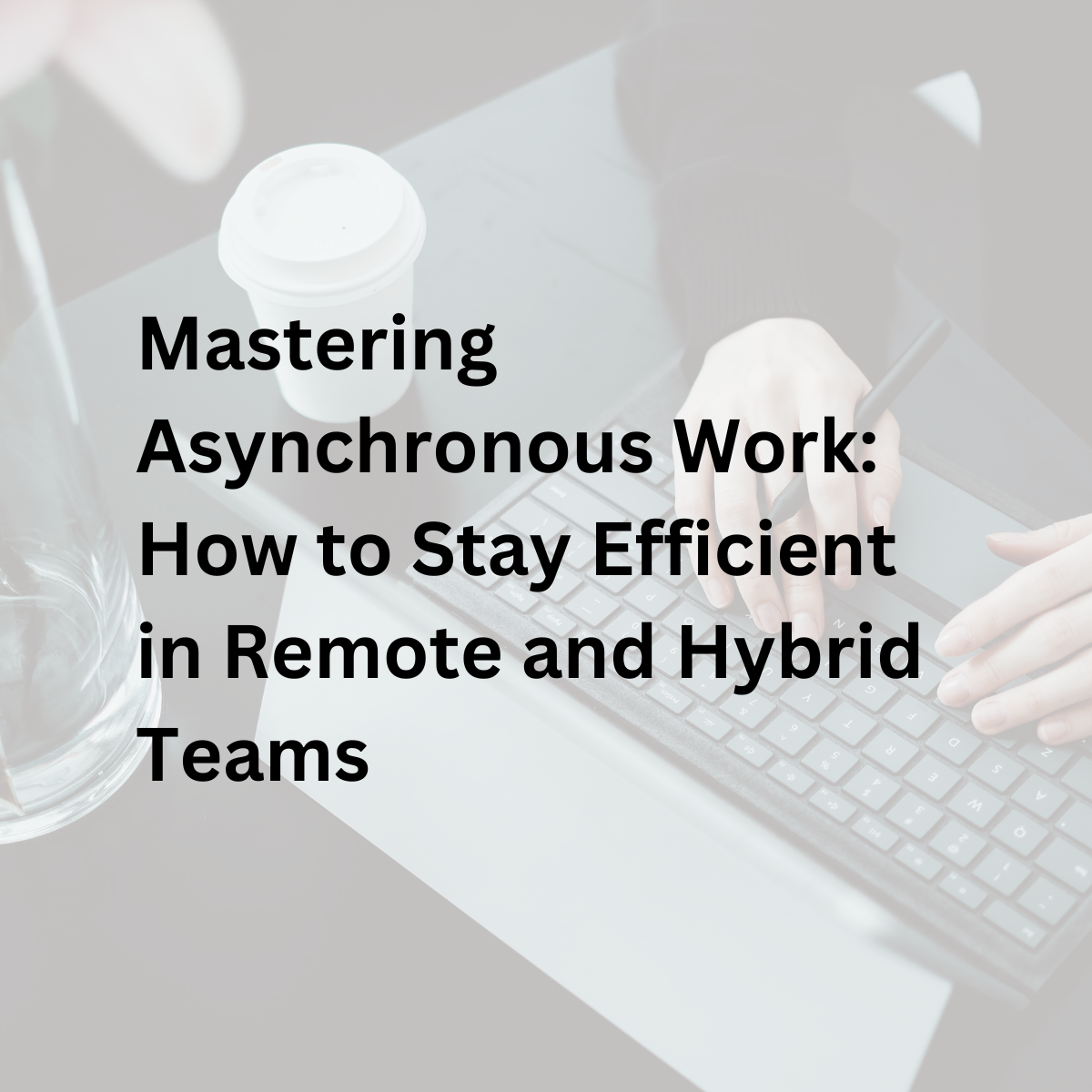The way we work has undergone a massive transformation over the last decade. With the rise of remote and hybrid work models, organizations are shifting from traditional synchronous communication to asynchronous work structures. This shift has become essential for global teams, distributed workforces, and employees seeking better work-life balance.
Asynchronous work enables employees to work at different times and in various locations without requiring real-time communication. While this flexibility offers many benefits, it also demands discipline, strategic planning, and effective communication to maintain efficiency.
In this comprehensive guide, we’ll explore the principles of asynchronous work, its advantages and challenges, essential tools, and actionable strategies to master it in remote and hybrid teams.
Understanding Asynchronous Work
What is Asynchronous Work?
Asynchronous work refers to a work model where team members do not need to be online or available at the same time to collaborate. Instead, they complete their tasks at their convenience while ensuring effective communication through documentation and digital tools.
Asynchronous vs. Synchronous Work
| Feature | Asynchronous Work | Synchronous Work |
|---|---|---|
| Communication Style | Time-independent | Real-time interaction |
| Examples | Emails, recorded videos, documents | Zoom calls, live chat, meetings |
| Work Hours | Flexible | Fixed or overlapping |
| Best Suited For | Remote, global, or hybrid teams | Teams requiring instant decisions |
Both models have their place in modern workplaces, but mastering asynchronous work can significantly enhance productivity, work-life balance, and cross-time-zone collaboration.
Benefits of Asynchronous Work
1. Increased Productivity and Focus
Synchronous meetings and instant messaging often interrupt deep work. Asynchronous work allows employees to structure their day based on peak productivity hours, reducing distractions and enhancing focus.
2. Greater Flexibility
Asynchronous work supports work-life balance by allowing employees to choose when and where they work, accommodating different time zones, personal commitments, and peak performance hours.
3. Inclusivity and Accessibility
It provides equal opportunities for team members across different regions, reducing the need for late-night or early-morning meetings. It also benefits individuals with disabilities by allowing them to engage in discussions at their own pace.
4. Improved Documentation and Knowledge Sharing
Since communication in asynchronous work heavily relies on written or recorded documentation, it creates a knowledge base that new employees can access, reducing redundancy and improving long-term efficiency.
5. Reduced Meeting Fatigue
Excessive meetings can drain energy and lower morale. Asynchronous work eliminates unnecessary meetings, making team interactions more meaningful and impactful.
Challenges of Asynchronous Work
While asynchronous work has numerous advantages, it also comes with challenges that teams must address for success.
1. Delayed Responses
Unlike synchronous work, where questions get answered instantly, asynchronous communication can lead to delayed responses, slowing down decision-making processes.
2. Lack of Immediate Feedback
When working asynchronously, employees may have to wait for feedback, which can be frustrating for urgent tasks or time-sensitive projects.
3. Miscommunication and Information Overload
Without verbal cues and real-time discussions, written messages can sometimes be misinterpreted, leading to confusion. Additionally, an overload of emails, documents, and messages can become overwhelming.
4. Accountability and Visibility Issues
Since employees work independently, it can be challenging to track progress, ensuring everyone is on the same page.
5. Social Isolation
Lack of real-time interaction may make employees feel disconnected from their team, affecting collaboration and engagement.
Best Practices for Mastering Asynchronous Work
To make asynchronous work effective, organizations and teams must establish best practices and clear communication strategies.
1. Set Clear Expectations and Guidelines
- Define core working hours for partial overlap, if needed.
- Establish response time expectations (e.g., 24-48 hours for emails).
- Set guidelines for documentation and communication channels.
2. Leverage the Right Tools
Effective asynchronous work depends on using the right digital tools for collaboration, project management, and communication. Some essential tools include:
| Category | Tools |
| Communication | Slack, Microsoft Teams, Twist |
| Documentation | Notion, Confluence, Google Docs |
| Project Management | Trello, Asana, ClickUp, Monday.com |
| Video Updates | Loom, Vidyard, Zoom (recorded meetings) |
| File Sharing | Google Drive, Dropbox, OneDrive |
| Time Management | Toggl, Clockify, RescueTime |
3. Improve Written Communication
Since asynchronous work heavily relies on written communication, clarity is crucial.
- Use bullet points and structured formatting.
- Keep messages concise and to the point.
- Avoid jargon and ambiguity.
- Provide enough context to eliminate back-and-forth clarifications.
4. Document Everything
- Maintain a centralized knowledge base.
- Record key decisions, meeting summaries, and project updates.
- Encourage team members to document their workflows and best practices.
5. Use Video for Complex Communication
For discussions that require detailed explanations, recorded video messages using Loom or Zoom can help convey context more effectively than text.
6. Implement a “No Meeting” Culture (When Possible)
- Reduce unnecessary meetings by replacing them with recorded updates or written summaries.
- Conduct async check-ins instead of daily stand-ups.
- Schedule meetings only when real-time discussion is essential.
7. Foster a Strong Team Culture
- Encourage team bonding through virtual social events.
- Schedule periodic synchronous team check-ins to maintain connection.
- Recognize and celebrate team achievements through public shout-outs or asynchronous appreciation.
8. Encourage Accountability and Transparency
- Use project management tools for task tracking.
- Set clear goals and deadlines.
- Encourage team members to update their progress regularly.
9. Train Teams on Asynchronous Best Practices
- Offer training sessions on effective asynchronous communication.
- Share resources and guides on optimizing workflow in an async environment.
10. Balance Asynchronous and Synchronous Work
- While async work is efficient, some level of synchronous interaction is necessary for brainstorming, problem-solving, and relationship-building.
- Conduct regular team sync-ups (weekly or bi-weekly) to align and strengthen team dynamics.
Case Studies: Companies Successfully Using Asynchronous Work
1. GitLab
GitLab is a fully remote company with over 2,000 employees worldwide. They have mastered asynchronous work by implementing a handbook-first approach, where every decision and process is documented in a company-wide knowledge base, reducing the need for real-time meetings.
2. Automattic (WordPress)
Automattic, the parent company of WordPress, operates as a remote-first company with a strong emphasis on asynchronous collaboration. They use Slack, P2 blogs, and Zoom recordings to keep employees connected while allowing flexible work schedules.
3. Buffer
Buffer, a social media management company, thrives on an asynchronous-first culture, limiting meetings and relying on Slack, Notion, and recorded video updates for collaboration.
Conclusion: The Future of Work is Asynchronous
Mastering asynchronous work is key to thriving in the evolving world of remote and hybrid work. By leveraging the right tools, setting clear expectations, improving communication, and fostering a culture of accountability, organizations can maximize efficiency while offering employees greater flexibility and autonomy.
While synchronous work still has its place, the future of work is shifting towards async-first models, enabling global teams to work smarter, not harder. Companies and professionals who embrace this shift will gain a competitive edge in productivity, collaboration, and work-life balance.
Take Action Today
- Evaluate your current workflow and identify areas for async optimization.
- Implement the best practices outlined in this guide.
- Start reducing unnecessary meetings and prioritize clear, documented communication.
Asynchronous work isn’t just a trend—it’s the future of efficient, flexible, and high-performing teams!







